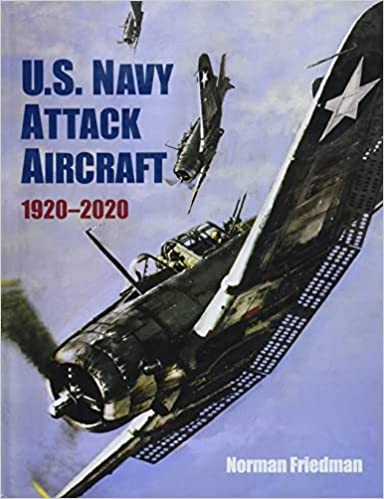
US Navy Attack Aircraft 1920-2020. By Norman Friedman. Naval Institute Press, Annapolis, Maryland, 2022. ISBN 978-1-68247-417-4
Reviewed by David Hobbs
Norman Friedman has lectured extensively in Australia as part of the Sea Power Centre’s King-Hall history conferences and has written a large number of books on contemporary and historical naval technology which be well known to ANI members. In this book he describes the attack aircraft used by the USN from the earliest days of carrier aviation, through both hot and cold wars with his customary analytical skill.
His research was based mainly on documents held in the US National Archives and in the old Naval Aviation Division of the Naval History and Heritage Command but he also made use of documents held by the Naval Air Systems Command history division and Grumman, the firm that designed and built many of the aircraft described.
Friedman has written this book from the perspective of naval requirements and how they were met rather than listing manufacturers and their products. This gives him the opportunity to discuss the evolution of requirements over the years and to examine the various submissions put forward to meet them as well as the aircraft that actually went into service. It also allows him to describe how the navy used attack aircraft in different eras and how tactics developed as technology advanced. The result is a fascinating and very readable account of attack aircraft evolution in a service that has always been at the forefront of their design and operation.
Logically, the book starts with a description of the aircraft carriers from which attack aircraft were intended to operate. Successive chapters then cover the development of torpedo and dive bombers together with the way in which they were used and improved during World War II. The introduction of jet-powered attack aircraft with strategic capabilities, the nuclear era and the return to conventional operations in limited conflicts after the end of the Cold War are all covered in forensic detail explaining why aircraft were specified to do what they did and to what extent they met their design aims. Towards the end of the text the Vietnam War and the post-Cold War requirement for aircraft capable of fighting a war at sea against and enemy fleet of equivalent capability are discussed. Aircraft development is described in the main text but individual type details such as wingspan, powerplant, weight and radius of action are listed in a series of five data tables after the main text so that aircraft of similar type can be compared. They cover torpedo, dive, single-seat, strategic and light jet bombers. The wealth of material the author must have analysed to create this book is reflected in the page and source notes which cover just under 100 pages of this 470 page book. As one would expect there is a carefully prepared index.
Whilst this book is focused on the USN and the aircraft it procured to meet its attack requirements, it does have significant Australian relevance. A number of pages are devoted to Ed Heineman’s superb A4 Skyhawk and describe how this remarkable aircraft evolved. Embarked in HMAS Melbourne it gave successive Australian Governments a greater range of capabilities than many politicians seem to have comprehended and still had much to offer when it was withdrawn prematurely from RAN service. The evolution of the F/A-18 Hornet into the F/A-18E/F Super Hornet is also covered extensively explaining how it originated and then survived as a back up to other more exotic aircraft designs which were cancelled. The fact that the Australian Defence Force chooses to operate its Super Hornets in a limited way from land-locked bases rather than realise the full potential from the sea for which they were designed should not detract from the interesting story of how the type evolved and its story places the Australian aircraft in context. Lastly there is a description of the how the F-35 Lightning II evolved. Whilst this focuses mainly on the ‘B’ version for the USMC and ‘C’ version for the USN this part of the book still has relevance for the ‘A’ version purchased for operation ashore by Australia. For obvious reasons, however, this section has less detail about how the latest aircraft are operated. No doubt this is because only limited quantities of relevant data have arrived in the public archives Friedman searched. In 2020 when this book’s narrative began to be prepared for publication the F-35 was only just entering operational service and there was still much to learn about its impressive capabilities. There still is. Hopefully, however, a future edition will carry the story forward; there is certainly scope for it with unmanned aircraft and a new generation of strike fighters at the concept stage in 2022.
In summary this is a well-researched, analytical, description of how attack aircraft evolved to meet USN requirements from the earliest days of carrier aviation up to 2020. Their story is fascinating and the description of how the A4 Skyhawk evolved is of particular interest to the RAN. The F/A-18 and F-35 are also interesting from an Australian perspective beside describing, in detail, how the American system of procurement has evolved and how it works today. Given Norman Friedman’s depth of knowledge and the vast amount of material he examined to create it, this book is likely to be the definitive reference work on this subject for several years to come and I thoroughly recommend it.



